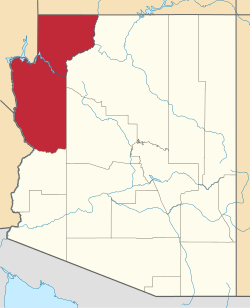Geography
Mohave Valley is located in western Mohave County in the valley of the same name, drained by the Colorado River. The CDP is on the east side of Arizona State Route 95, which leads 3 miles (5 km) north to Fort Mohave, 16 miles (26 km) north to Bullhead City, and 6 miles (10 km) south to Needles, California, across the Colorado River. The Mohave Valley CDP is bordered to the south by Arizona Village, to the west by Willow Valley, and to the north by Mohave Ranch Estates, all CDPs.
According to the United States Census Bureau, the Mohave Valley CDP has a total area of 14.0 square miles (36 km2), of which 0.02 square miles (0.05 km2), or 0.11%, are water. [1]
Demographics
Historical population| Census | Pop. | Note | %± |
|---|
| 1990 | 6,962 | | — |
|---|
| 2000 | 13,694 | | 96.7% |
|---|
| 2010 | 2,616 | | −80.9% |
|---|
| 2020 | 2,693 | | 2.9% |
|---|
|
As of the census [10] of 2000, there were 13,694 people, 5,217 households, and 3,850 families residing in the CDP. The population density was 302.6 inhabitants per square mile (116.8/km2). There were 6,672 housing units at an average density of 147.4 per square mile (56.9/km2). The racial makeup of the CDP was 90.8% White, 0.5% Black or African American, 2.3% Native American, 0.9% Asian, 0.1% Pacific Islander, 3.3% from other races, and 2.1% from two or more races. 12.0% of the population were Hispanic or Latino of any race.
There were 5,217 households, out of which 29.6% had children under the age of 18 living with them, 59.4% were married couples living together, 9.1% had a female householder with no husband present, and 26.2% were non-families. 19.0% of all households were made up of individuals, and 8.1% had someone living alone who was 65 years of age or older. The average household size was 2.61 and the average family size was 2.94.
In the CDP, the population was spread out, with 24.6% under the age of 18, 5.7% from 18 to 24, 25.8% from 25 to 44, 27.4% from 45 to 64, and 16.5% who were 65 years of age or older. The median age was 41 years. For every 100 females, there were 101.9 males. For every 100 females age 18 and over, there were 100.9 males.
The median income for a household in the CDP was $34,321, and the median income for a family was $38,897. Males had a median income of $29,719 versus $21,271 for females. The per capita income for the CDP was $16,287. About 7.9% of families and 11.0% of the population were below the poverty line, including 15.5% of those under age 18 and 6.1% of those age 65 or over.
This page is based on this
Wikipedia article Text is available under the
CC BY-SA 4.0 license; additional terms may apply.
Images, videos and audio are available under their respective licenses.




